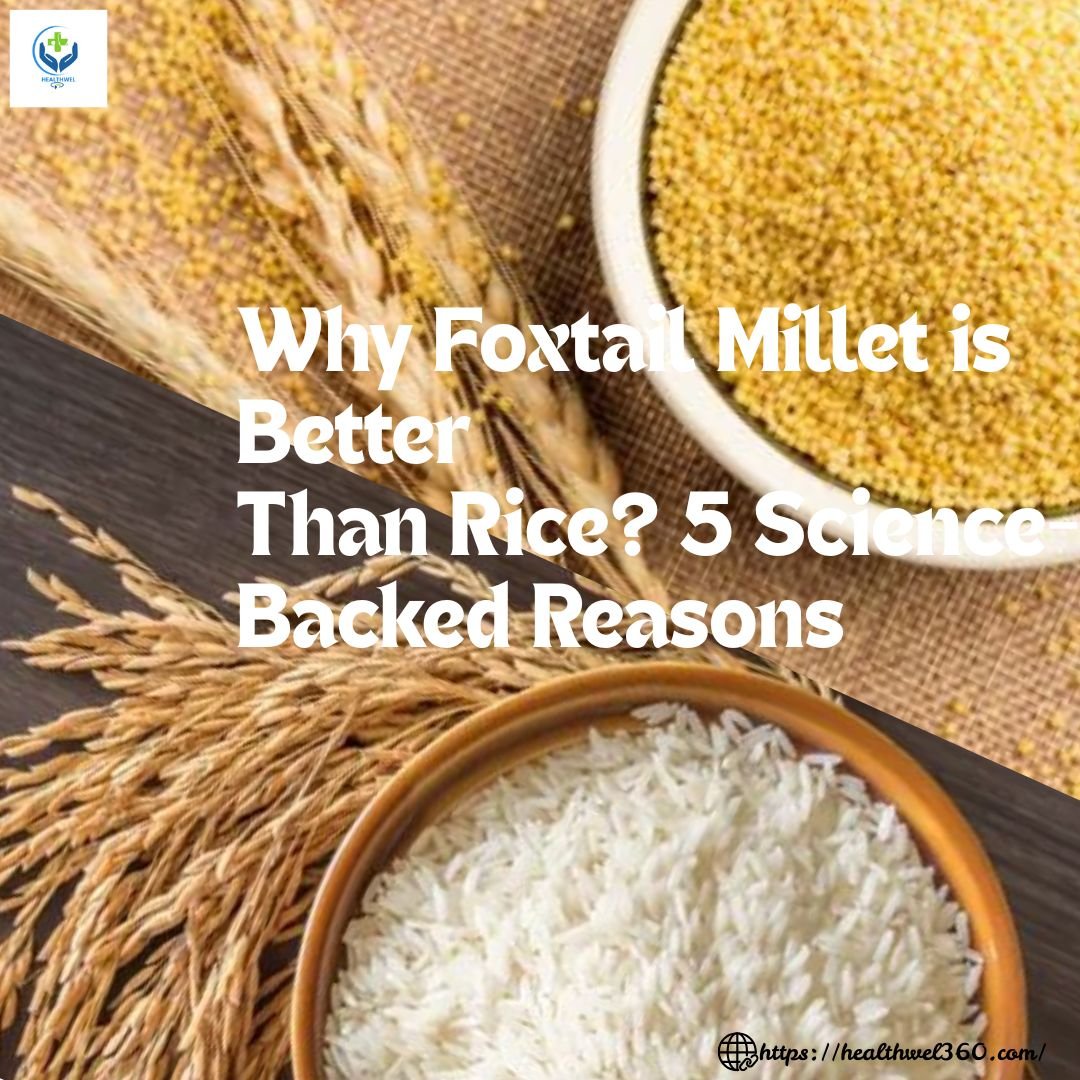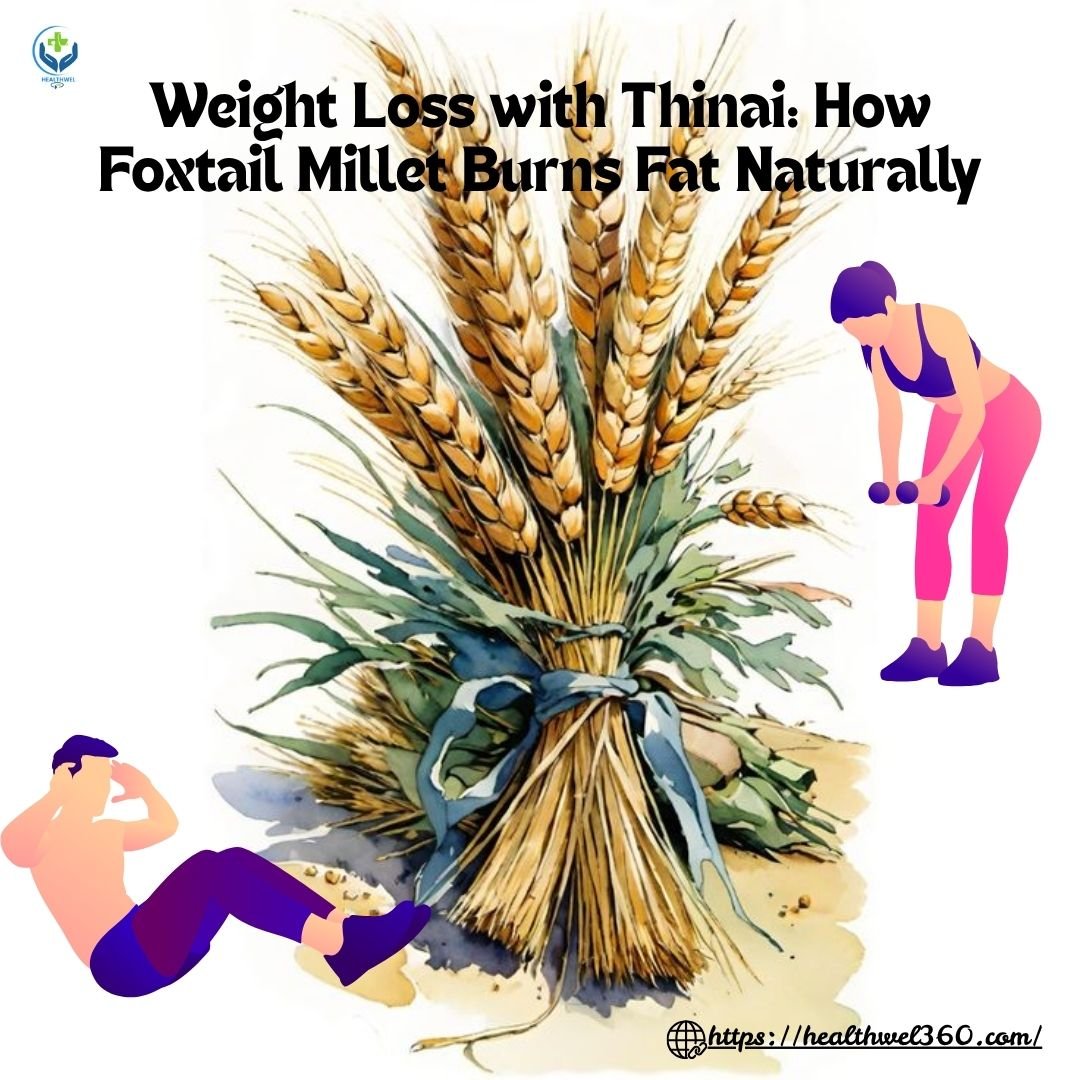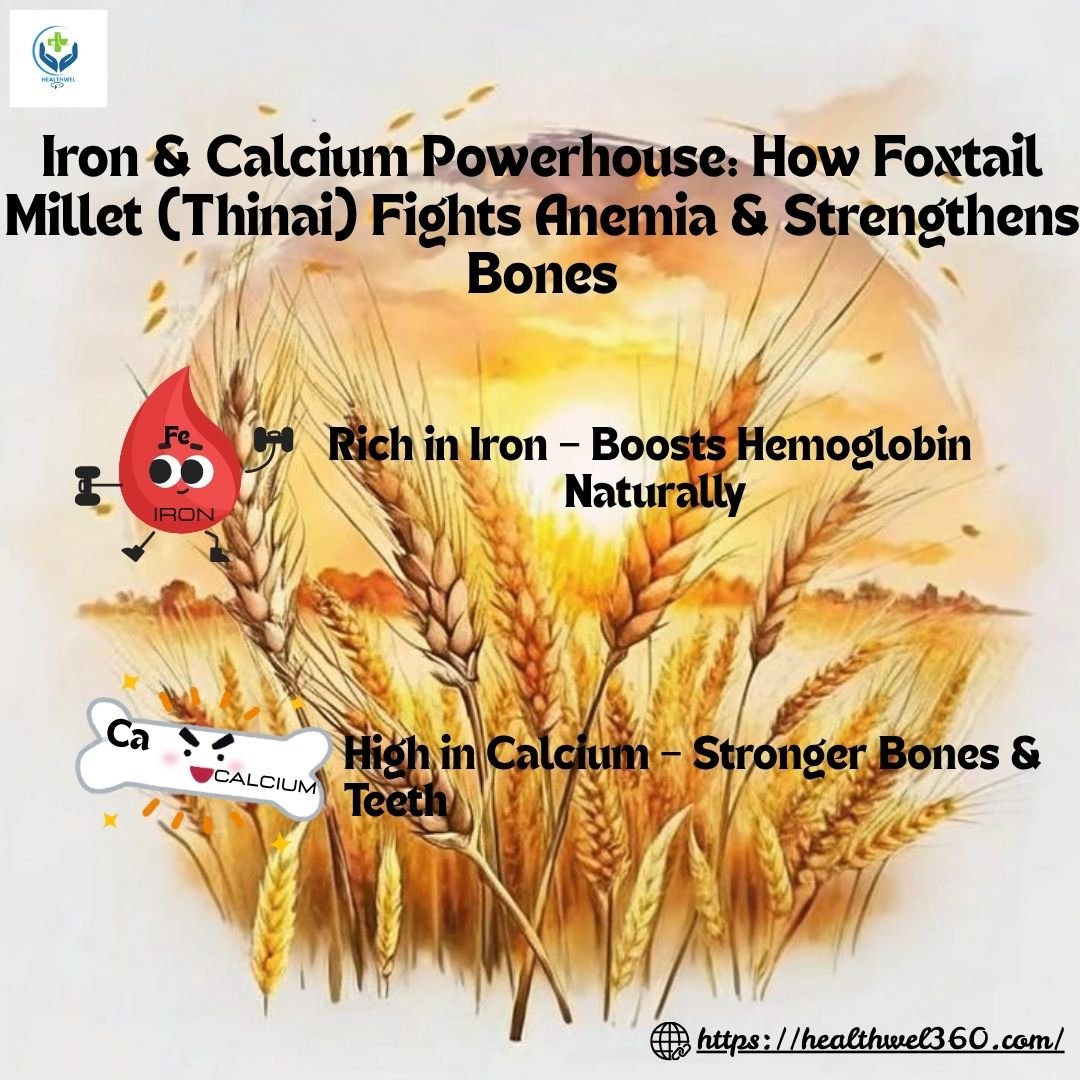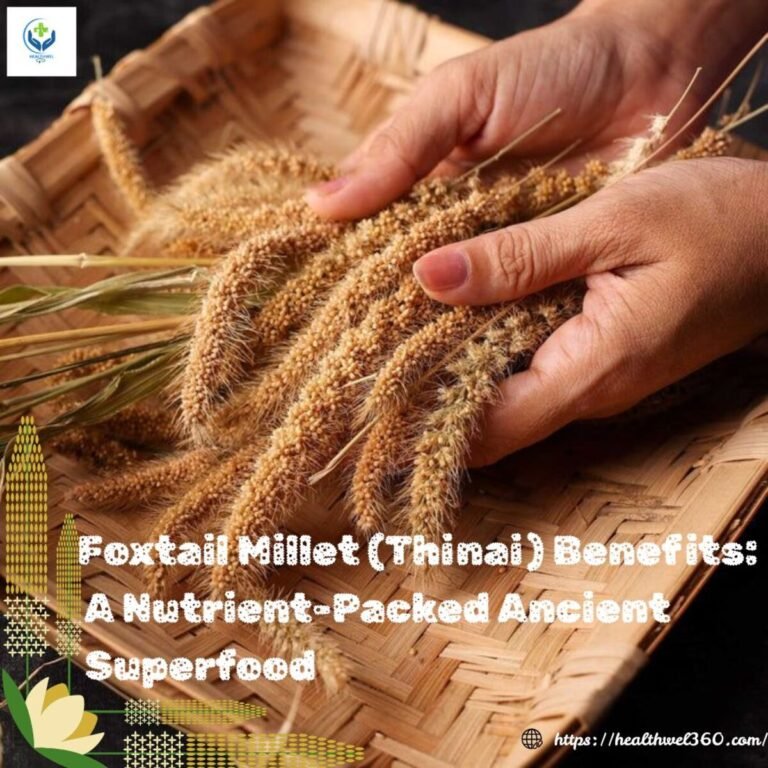Foxtail Millet (Thinai) Benefits: A Nutrient-Packed Ancient Superfood. Foxtail millet, known as தினை (Thinai) in Tamil, is one of the oldest cultivated millets, valued for its nutritional benefits and versatility. A staple in traditional South Indian cuisine, this gluten-free grain is making a comeback as a superfood in modern diets.
Foxtail Millet (Thinai): The Ancient Tamil Superfood for Modern Health
Foxtail millet, or தினை (Thinai), is an essential of classical Tamil cooking. Revered for centuries in South India, this ancient millet is now gaining global recognition as a nutrient-dense superfood, perfect for today’s health-conscious lifestyles.
Why Thinai? The Tamil Heritage Grain
Thinai was a mainstay in Sangam-era cuisine and is even mentioned in Tamil literature is an emblem of health and wealth. Unlike refined grains, foxtail millet retains its natural goodness, making it a sustainable and wholesome choice for modern diets.
Top 5 Health Benefits of Thinai
- Diabetes-Friendly Grain
- A low Glycaemic Index (GI) helps control blood sugar levels.
- Rich in dietary fiber, slowing glucose absorption.
- Boosts Heart Health
- Magnesium helps maintain healthy blood pressure.
- Lowers LDL cholesterol, and improves heart function.
- Aids Digestion & Weight Loss
- High fiber content prevents constipation and bloating.
- Keeps you satisfied for longer, minimising unnecessary snacking.
- Gluten-Free & Rich in Protein
- Perfect for celiac disease or gluten-sensitive individuals.
- Contains 12% protein, ideal for vegetarians and vegans.
- Strengthens Bones & Immunity
- Packed with calcium and iron—great for bone density and anemia prevention.
- Loaded with antioxidants that fight inflammation.
How to Include Thinai in Your Diet?
Thinai is incredibly versatile—here are some delicious ways to enjoy it:
🍚 As a Rice Substitute
- Cook like rice and pair with sambar, rasam, or curd.
- Use in biryanis or pulao for a nutty, wholesome flavor.
🥣 Healthy Breakfast Options
- Thinai Kanji (Porridge) – Cook with milk/jaggery for energy.
- Foxtail Millet Dosa/Idli – Ferment with urad dal for gut-friendly meals.
🍪 Snacks & Desserts
- Thinai Ladoo – Roasted millet with nuts and jaggery.
- Millet Cookies – A guilt-free crunchy snack.
Thinai vs. Modern Grains: Why Switch?
- This crop has higher nutritional value than white rice and wheat.
- Additionally, it is an eco-friendly crop that uses less water and can grow in dry conditions.
- Preserves Tamil culinary heritage while boosting health.
Why Foxtail Millet is Better Than Rice? 5 Science-Backed Reasons

For centuries, rice has dominated our plates, but modern science reveals that foxtail millet (Thinai) is the smarter, healthier choice. Packed with nutrients and backed by research, this ancient grain outperforms white rice in almost every way. Here’s why you should switch to foxtail millet today!
- Lower Glycaemic Index – Better for Blood Sugar Control
🔬 Science Says:
- Foxtail millet (GI: 50-55) releases sugar slowly, preventing spikes.
- White rice (GI: 73) causes rapid glucose surges, increasing diabetes risk.
- A 2021 study in Frontiers in Nutrition found millets reduce fasting blood sugar by 12-15% compared to rice.
✅ Why It Matters?
✔ Ideal for diabetics & weight watchers.
✔ Keeps energy levels stable, avoiding crashes.
- More Protein – Builds Muscle & Keeps You Full Longer
🔬 Science Says:
- Foxtail millet: 12g protein per 100g (vs. rice: 2.7g).
- Contains necessary amino acids that are required for muscle healing.
- A 2019 study in Food Chemistry showed millet protein helps reduce obesity & inflammation.
✅ Why It Matters?
✔ Great for vegetarians & fitness enthusiasts.
✔ Reduces hunger pangs, aiding weight loss.
- 10X More Fiber – Improves Digestion & Gut Health
🔬 Science Says:
- Foxtail millet: 6.7g fiber per 100g (vs. rice: 0.4g).
- Fiber feeds good gut bacteria, reducing bloating & constipation.
- Research in The Lancet links high-fiber diets to lower colon cancer risk.
✅ Why It Matters?
✔ Prevents digestive issues like IBS & acidity.
✔ Supports a healthy microbiome.
- Rich in Iron & Calcium – Fights Anemia & Strengthens Bones
🔬 Science Says:
- Foxtail millet: 6mg iron & 31mg calcium per 100g (vs. rice: 0.8mg iron & 10mg calcium).
- A 2020 study in Nutrients found millet eaters had higher hemoglobin levels.
✅ Why It Matters?
✔ Combats anemia & fatigue naturally.
✔ Better for bone health than rice.
- More Sustainable – Needs Less Water & Pesticides
🔬 Science Says:
- Foxtail millet uses 70% less water than rice.
- Grows in drought conditions, reducing farmer dependency on rains.
- A UN report highlights millets as future-proof crops for climate change.
✅ Why It Matters?
✔ Eco-friendly choice for a greener planet.
✔ Saves water & reduces carbon footprint.
Should You Switch from Rice to Foxtail Millet?
✅ Yes! Science proves foxtail millet is:
✔ Healthier (controls sugar, boosts protein & fiber).
✔ More nutritious (iron, calcium, magnesium).
✔ Better for the planet (sustainable farming).
Try replacing rice with Thinai in meals—your body & the Earth will thank you!
Foxtail Millet for Diabetes: How Thinai Helps Control Blood Sugar

Diabetes has become a global health crisis, but ancient grains like Foxtail Millet (Thinai) offer a natural way to manage blood sugar levels. A staple in traditional Tamil cuisine, Thinai is now gaining recognition as one of the best millets for diabetics. Let’s explore how this humble grain can help in diabetes management.
Why is Foxtail Millet (Thinai) Good for Diabetes?
- Low Glycemic Index (GI) – Prevents Sugar Spikes
- Thinai has a GI of 50-55, much lower than white rice (73) or wheat (70).
- Releases glucose slowly into the bloodstream, preventing sudden sugar surges.
- Higher Fiber Materials: Slows Glucose Absorption.
- Rich in dietary fiber, which delays digestion and keeps blood sugar stable.
- Reduces insulin resistance, making it ideal for Type 2 Diabetes.
- Rich in Magnesium – Improves Insulin Sensitivity
- Magnesium helps regulate insulin secretion and glucose metabolism.
- Studies show that magnesium deficiency is linked to higher diabetes risk.
- Gluten-Free & Nutrient-Dense Alternative
- Unlike refined grains, Thinai retains its natural nutrients, supporting overall health.
- Good for diabetic who are gluten intolerant or have coeliac disease.
How to Include Thinai in a Diabetic Diet?
✅ Best Ways to Consume Foxtail Millet for Diabetes
- Replace rice with Thinai in meals (e.g., millet rice with sambar/curd).
- Thinai Porridge (Kanji) – Cook with vegetables or buttermilk for a low-GI breakfast.
- Millet Dosa/Idli – Fermented foods improve gut health and blood sugar control.
- Thinai Upma/Pongal is a diabetic-friendly spicy alternative.
❌ What to Avoid?
- Extreme sweetness (a plant-based or cinnamon as well ahead of sugars or jaggery).
- Deep-fried millet snacks (opt for roasted or steamed preparations).
Scientific Evidence: Thinai for Blood Sugar Control
- A 2018 study published in Frontiers in Nutrition found that millets like foxtail millet significantly lowered fasting blood glucose levels.
- According to research published in the International Journal of Nutrition, magnesium-rich foods (such as Thinai) may decrease the risk of diabetes by 15-20%.
Weight Loss with Thinai: How Foxtail Millet Burns Fat Naturally

Struggling to shed those extra pounds? The secret might lie in an ancient Tamil superfood—Thinai (Foxtail Millet)! Packed with metabolism-boosting nutrients, this humble grain is a natural fat-burning powerhouse that can help you lose weight sustainably.
Why Thinai is Perfect for Weight Loss?
- High Fiber Keeps You Full Longer
- Thinai is rich in dietary fiber, which slows digestion and prevents overeating.
- Reduces cravings by keeping you satisfied for hours.
- Low Glycemic Index (GI) – No Sugar Crashes
- With a GI of just 50-55, it prevents insulin spikes that trigger fat storage.
- Unlike white rice or wheat, it provides steady energy without weight gain.
- Boosts Metabolism Naturally
- Contains magnesium & B vitamins, which help convert food into energy efficiently.
- Improves thyroid health, which is essential for maintaining a suitable weight.
- Low in Calories, High in Nutrition
- 100g of Thinai = ~330 kcal (compared to rice at ~350 kcal + less filling).
- High in protein (12%), which helps maintain muscle while decreasing fat.
Best Ways to Eat Thinai for Weight Loss
✅ Do’s:
✔ Replace rice with Thinai in meals (try millet rice + veggie curry).
✔ Thinai Porridge (Kanji) – Cook with veggies or buttermilk for a light dinner.
✔ Millet Salad – Toss cooked Thinai with cucumbers, tomatoes & lemon.
✔ Roasted Thinai Snacks – A crunchy, low-calorie alternative to chips.
❌ Don’ts:
✖ Avoid frying (opt for steaming, boiling, or roasting).
✖ Don’t overload with sugary toppings (use herbs & spices instead).
Science Behind Thinai & Fat Loss
- A 2021 study in Food & Function found that millet-based diets reduced belly fat in participants.
- The high fiber content promotes gut health, linked to better weight management.
Thinai vs. Other Weight Loss Foods
| Food | Calories (100g) | Fiber (g) | Protein (g) | Best For Weight Loss? |
| Thinai | 330 | 6.7 | 12 | ✅ YES (Low GI + High Fiber) |
| Brown Rice: | 350 | 3.4 | 7 | ❌ Least filling. |
| Quinoa | 368 | 7 | 14 | ✅ Good but expensive |
| Oatmeal | 389 | 10.6 | 16.9 | ✅ Great, but more in calories. |
Can Thinai Help You Lose Weight?
Absolutely! Thinai is a smarter carb choice—it keeps you full, burns fat naturally, and prevents energy crashes. By replacing refined flour with Thinai, you may lose fat with starving or following strict regimens.
Pro Tip: Combine Thinai with protein (dal/curd) & veggies for maximum fat loss!
Iron & Calcium Powerhouse: How Foxtail Millet (Thinai) Fights Anemia & Strengthens Bones

Struggling with fatigue, weakness, or brittle bones? The ancient Tamil superfood Thinai (Foxtail Millet) might be your natural solution! Packed with iron for blood health and calcium for strong bones, this humble grain is a nutritional powerhouse that can help combat anemia and osteoporosis naturally.
Why Thinai is a Must for Anemia & Bone Health?
1. Rich in Iron – Boosts Hemoglobin Naturally
- Provides 6 milligrams of this mineral per 100g (vs 0.8 milligrams in rice).
- Helps prevent iron-deficiency anemia, especially in women & children.
- Enhances oxygen circulation, reducing fatigue and weakness.
2. High in Calcium – Stronger Bones & Teeth
- Contains 31 mg of calcium per 100g (more than rice or wheat).
- Prevents bone loss, fractures, and osteoporosis as you age.
- Works best when paired with vitamin D (sunlight, fish, or eggs).
3. Packed with Magnesium & Phosphorus
- Magnesium promotes the absorption of calcium for stronger bones.
- While phosphorus maintains bone density.
4. Natural Folate (Vitamin B9) – Prevents Anemia
- Supports red blood cell production, crucial for anemia patients.
- Especially beneficial for pregnant women to prevent birth defects.
Best Ways to Eat Thinai for Maximum Iron & Calcium Absorption
✅ Iron-Boosting Combos
✔ Thinai + Vitamin C (Lemon/Tomatoes) – Enhances iron absorption.
✔ Thinai + Greens (Spinach, Drumstick Leaves) – Doubles iron intake.
✔ Thinai + Jaggery (Moderate) – Traditional anemia-fighting combo.
✅ Calcium-Rich Preparations
✔ Thinai Kanji with Milk – Strengthens bones naturally.
✔ Millet Dosa with Sesame Seeds – High-calcium breakfast.
✔ Thinai Porridge with Almonds – A bone-healthy snack.
❌ What to Avoid?
✖ Excess tea/coffee with meals (blocks iron absorption).
✖ High-salt diets (leaches calcium from bones).
Thinai vs. Other Grains: Who Wins?
| Nutrient (per 100g) | Thinai | Rice | Wheat | Winner? |
| Iron (mg) | 6.3 | 0.8 | 3.9 | ✅ Thinai |
| Calcium (mg) | 31 | 10 | 34 | 🥈 Close, but Thinai has more iron! |
| Magnesium (mg) | 81 | 12 | 138 | ✅ Balanced in Thinai |
Scientific Backing: Thinai for Anemia & Bones
- A 2020 study in Nutrients found millets improved iron levels in anemic women.
- Research in Osteoporosis International shows magnesium-rich diets reduce fracture risk by 30%.
Is Thinai the Best Grain for Blood & Bone Health?
Yes! Foxtail millet (Thinai) is a natural, affordable, and effective way to:
✔ Fight anemia with its high iron & folate content.
✔ Strengthen bones with calcium, magnesium & phosphorus.
✔ Boost overall vitality without supplements!
Try replacing rice with Thinai today and feel the difference!
Have you used Thinai for anemia or bone health? Share your tips below!




